Strategic Management Accounting: BSC and IT Literature Review Report
VerifiedAdded on 2023/06/04
|8
|1825
|102
Report
AI Summary
This report provides a comprehensive review of the literature concerning the Balanced Scorecard (BSC) and its application within the realm of Information Technology (IT). It begins with an introduction to the BSC, including its origins and purpose as a strategic management tool for performance measurement, and its four key perspectives: financial, customer, internal business processes, and innovation and learning. The report then delves into the existing literature, examining how the BSC is utilized in the IT industry to develop strategic goals and improve business growth. It highlights the integration of the BSC with IT systems for enhancing operational efficiency and assessing the performance of IT projects. Key issues and findings from the literature review are outlined, including the benefits of BSC in providing a comprehensive measure of performance and the challenges associated with its implementation, such as employee resistance and resource constraints. The report also discusses the strengths and weaknesses of the BSC, concluding with an overall assessment of its effectiveness as a strategic management tool in the IT sector.
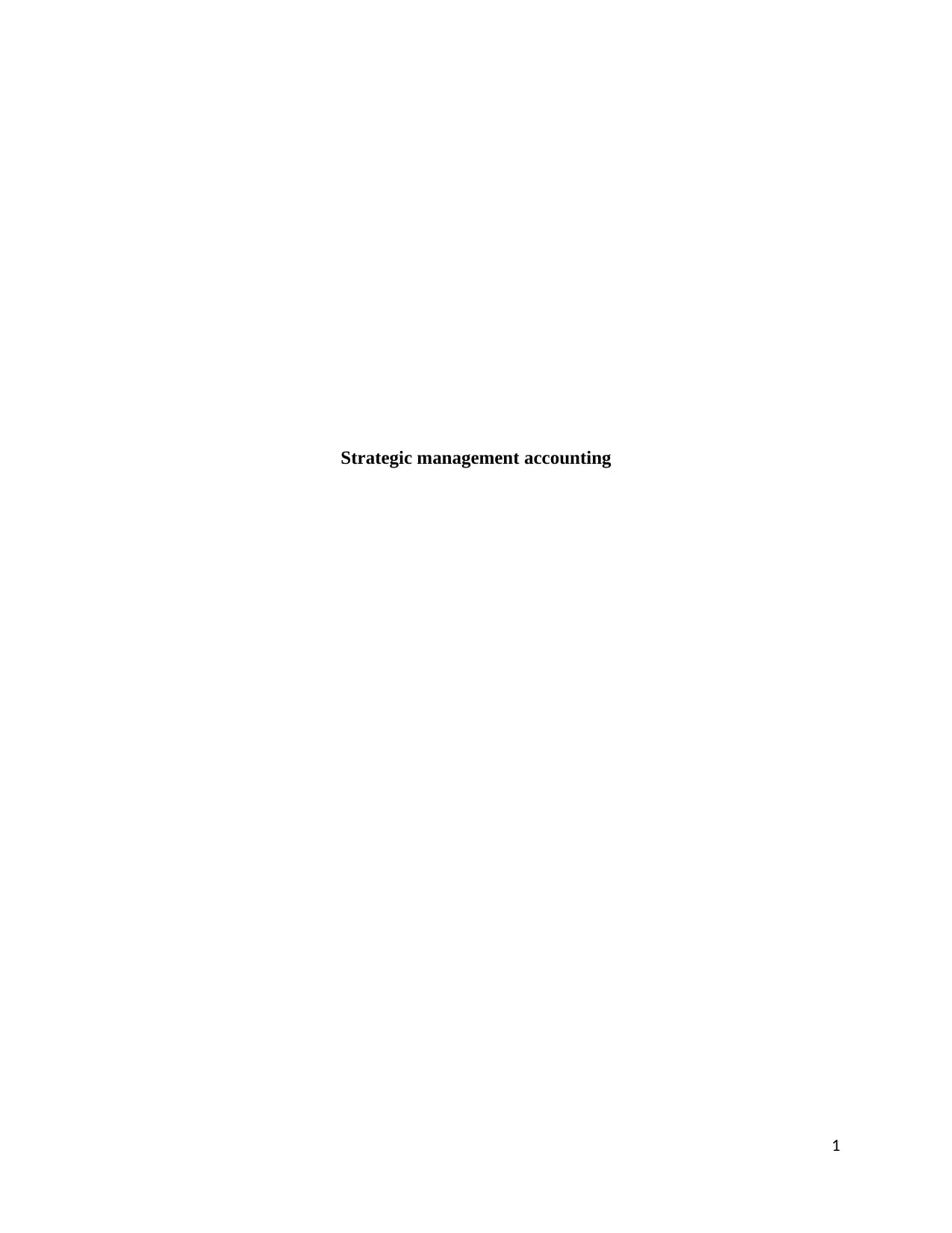
Strategic management accounting
1
1
Paraphrase This Document
Need a fresh take? Get an instant paraphrase of this document with our AI Paraphraser
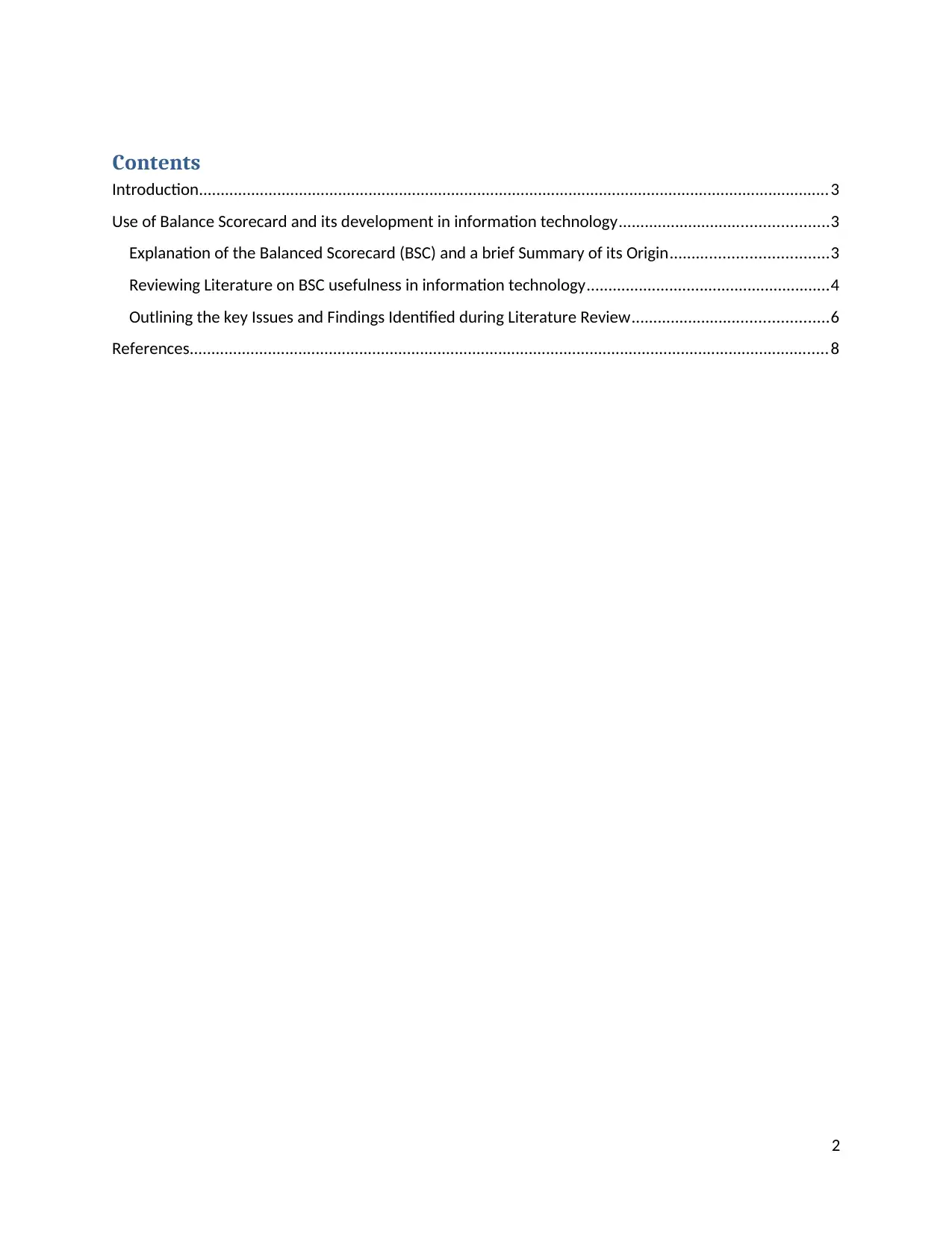
Contents
Introduction.................................................................................................................................................3
Use of Balance Scorecard and its development in information technology................................................3
Explanation of the Balanced Scorecard (BSC) and a brief Summary of its Origin....................................3
Reviewing Literature on BSC usefulness in information technology........................................................4
Outlining the key Issues and Findings Identified during Literature Review.............................................6
References...................................................................................................................................................8
2
Introduction.................................................................................................................................................3
Use of Balance Scorecard and its development in information technology................................................3
Explanation of the Balanced Scorecard (BSC) and a brief Summary of its Origin....................................3
Reviewing Literature on BSC usefulness in information technology........................................................4
Outlining the key Issues and Findings Identified during Literature Review.............................................6
References...................................................................................................................................................8
2
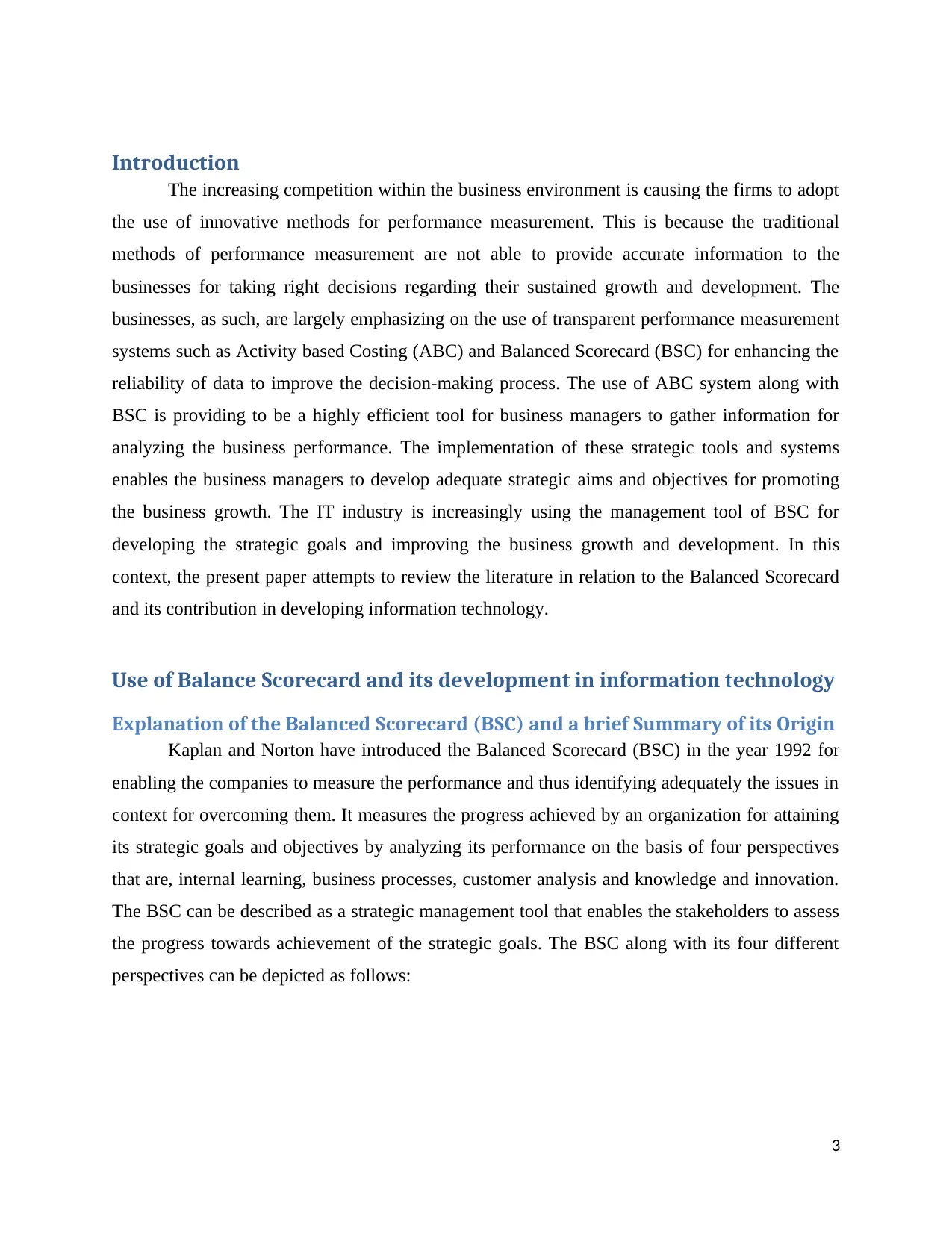
Introduction
The increasing competition within the business environment is causing the firms to adopt
the use of innovative methods for performance measurement. This is because the traditional
methods of performance measurement are not able to provide accurate information to the
businesses for taking right decisions regarding their sustained growth and development. The
businesses, as such, are largely emphasizing on the use of transparent performance measurement
systems such as Activity based Costing (ABC) and Balanced Scorecard (BSC) for enhancing the
reliability of data to improve the decision-making process. The use of ABC system along with
BSC is providing to be a highly efficient tool for business managers to gather information for
analyzing the business performance. The implementation of these strategic tools and systems
enables the business managers to develop adequate strategic aims and objectives for promoting
the business growth. The IT industry is increasingly using the management tool of BSC for
developing the strategic goals and improving the business growth and development. In this
context, the present paper attempts to review the literature in relation to the Balanced Scorecard
and its contribution in developing information technology.
Use of Balance Scorecard and its development in information technology
Explanation of the Balanced Scorecard (BSC) and a brief Summary of its Origin
Kaplan and Norton have introduced the Balanced Scorecard (BSC) in the year 1992 for
enabling the companies to measure the performance and thus identifying adequately the issues in
context for overcoming them. It measures the progress achieved by an organization for attaining
its strategic goals and objectives by analyzing its performance on the basis of four perspectives
that are, internal learning, business processes, customer analysis and knowledge and innovation.
The BSC can be described as a strategic management tool that enables the stakeholders to assess
the progress towards achievement of the strategic goals. The BSC along with its four different
perspectives can be depicted as follows:
3
The increasing competition within the business environment is causing the firms to adopt
the use of innovative methods for performance measurement. This is because the traditional
methods of performance measurement are not able to provide accurate information to the
businesses for taking right decisions regarding their sustained growth and development. The
businesses, as such, are largely emphasizing on the use of transparent performance measurement
systems such as Activity based Costing (ABC) and Balanced Scorecard (BSC) for enhancing the
reliability of data to improve the decision-making process. The use of ABC system along with
BSC is providing to be a highly efficient tool for business managers to gather information for
analyzing the business performance. The implementation of these strategic tools and systems
enables the business managers to develop adequate strategic aims and objectives for promoting
the business growth. The IT industry is increasingly using the management tool of BSC for
developing the strategic goals and improving the business growth and development. In this
context, the present paper attempts to review the literature in relation to the Balanced Scorecard
and its contribution in developing information technology.
Use of Balance Scorecard and its development in information technology
Explanation of the Balanced Scorecard (BSC) and a brief Summary of its Origin
Kaplan and Norton have introduced the Balanced Scorecard (BSC) in the year 1992 for
enabling the companies to measure the performance and thus identifying adequately the issues in
context for overcoming them. It measures the progress achieved by an organization for attaining
its strategic goals and objectives by analyzing its performance on the basis of four perspectives
that are, internal learning, business processes, customer analysis and knowledge and innovation.
The BSC can be described as a strategic management tool that enables the stakeholders to assess
the progress towards achievement of the strategic goals. The BSC along with its four different
perspectives can be depicted as follows:
3
⊘ This is a preview!⊘
Do you want full access?
Subscribe today to unlock all pages.

Trusted by 1+ million students worldwide
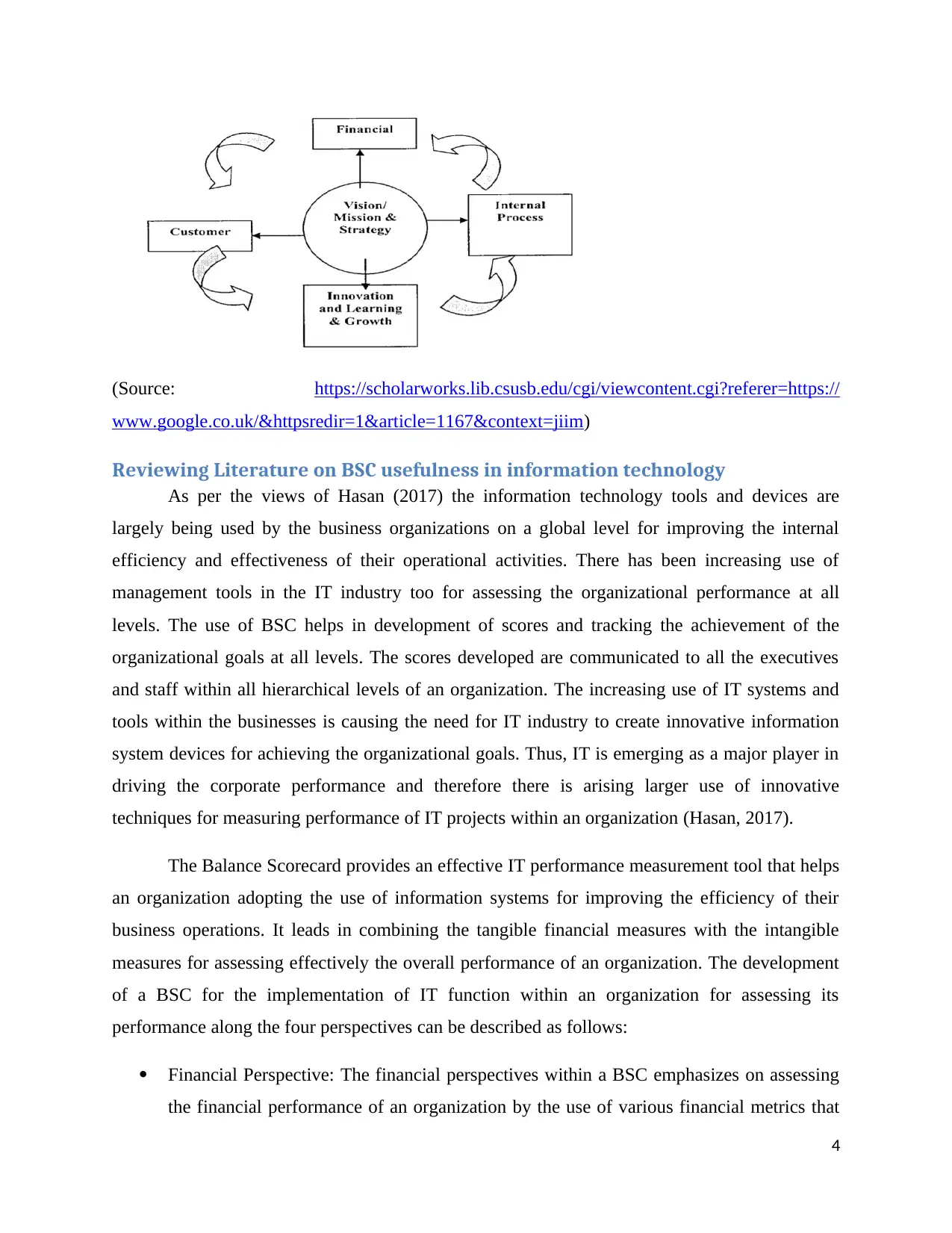
(Source: https://scholarworks.lib.csusb.edu/cgi/viewcontent.cgi?referer=https://
www.google.co.uk/&httpsredir=1&article=1167&context=jiim)
Reviewing Literature on BSC usefulness in information technology
As per the views of Hasan (2017) the information technology tools and devices are
largely being used by the business organizations on a global level for improving the internal
efficiency and effectiveness of their operational activities. There has been increasing use of
management tools in the IT industry too for assessing the organizational performance at all
levels. The use of BSC helps in development of scores and tracking the achievement of the
organizational goals at all levels. The scores developed are communicated to all the executives
and staff within all hierarchical levels of an organization. The increasing use of IT systems and
tools within the businesses is causing the need for IT industry to create innovative information
system devices for achieving the organizational goals. Thus, IT is emerging as a major player in
driving the corporate performance and therefore there is arising larger use of innovative
techniques for measuring performance of IT projects within an organization (Hasan, 2017).
The Balance Scorecard provides an effective IT performance measurement tool that helps
an organization adopting the use of information systems for improving the efficiency of their
business operations. It leads in combining the tangible financial measures with the intangible
measures for assessing effectively the overall performance of an organization. The development
of a BSC for the implementation of IT function within an organization for assessing its
performance along the four perspectives can be described as follows:
Financial Perspective: The financial perspectives within a BSC emphasizes on assessing
the financial performance of an organization by the use of various financial metrics that
4
www.google.co.uk/&httpsredir=1&article=1167&context=jiim)
Reviewing Literature on BSC usefulness in information technology
As per the views of Hasan (2017) the information technology tools and devices are
largely being used by the business organizations on a global level for improving the internal
efficiency and effectiveness of their operational activities. There has been increasing use of
management tools in the IT industry too for assessing the organizational performance at all
levels. The use of BSC helps in development of scores and tracking the achievement of the
organizational goals at all levels. The scores developed are communicated to all the executives
and staff within all hierarchical levels of an organization. The increasing use of IT systems and
tools within the businesses is causing the need for IT industry to create innovative information
system devices for achieving the organizational goals. Thus, IT is emerging as a major player in
driving the corporate performance and therefore there is arising larger use of innovative
techniques for measuring performance of IT projects within an organization (Hasan, 2017).
The Balance Scorecard provides an effective IT performance measurement tool that helps
an organization adopting the use of information systems for improving the efficiency of their
business operations. It leads in combining the tangible financial measures with the intangible
measures for assessing effectively the overall performance of an organization. The development
of a BSC for the implementation of IT function within an organization for assessing its
performance along the four perspectives can be described as follows:
Financial Perspective: The financial perspectives within a BSC emphasizes on assessing
the financial performance of an organization by the use of various financial metrics that
4
Paraphrase This Document
Need a fresh take? Get an instant paraphrase of this document with our AI Paraphraser
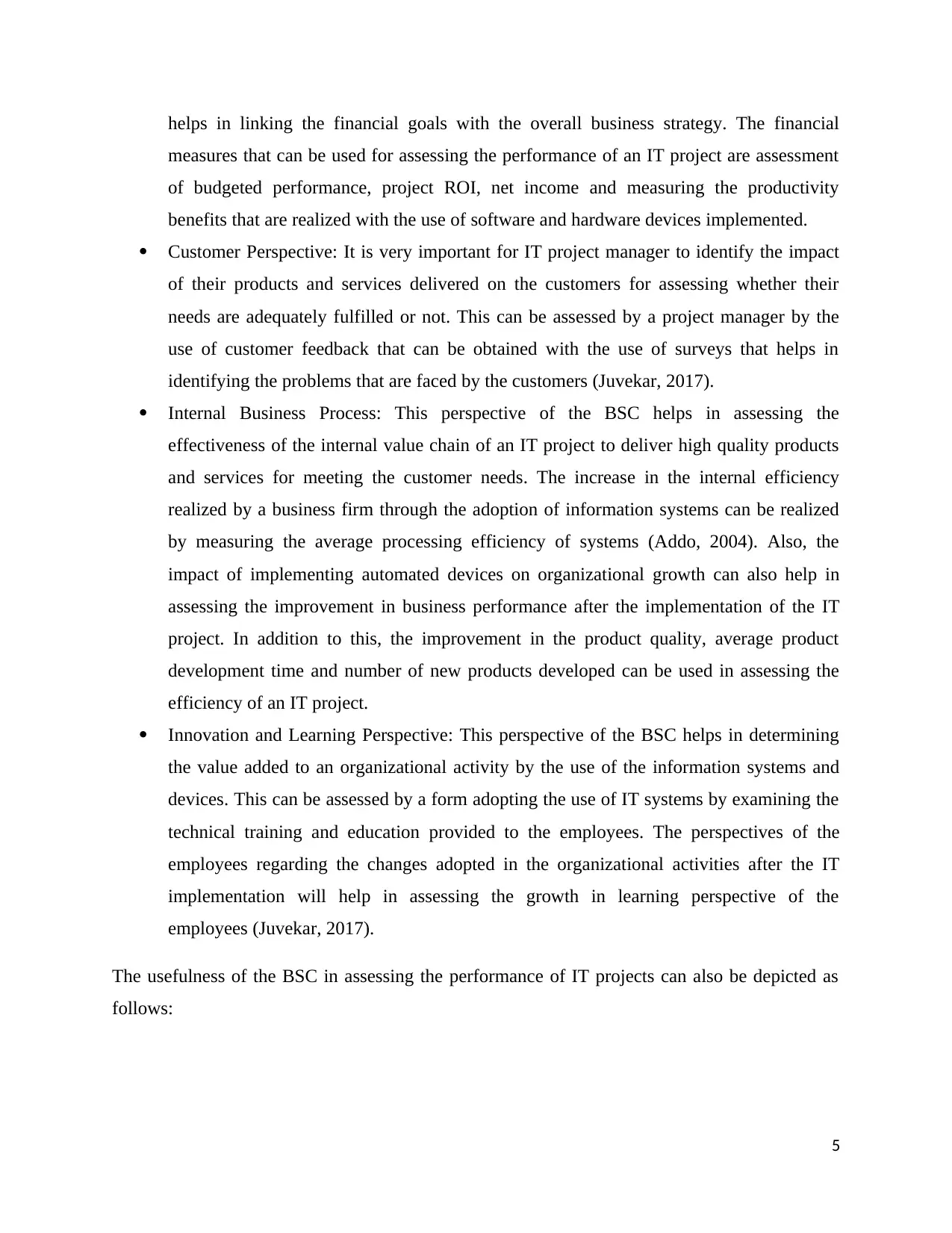
helps in linking the financial goals with the overall business strategy. The financial
measures that can be used for assessing the performance of an IT project are assessment
of budgeted performance, project ROI, net income and measuring the productivity
benefits that are realized with the use of software and hardware devices implemented.
Customer Perspective: It is very important for IT project manager to identify the impact
of their products and services delivered on the customers for assessing whether their
needs are adequately fulfilled or not. This can be assessed by a project manager by the
use of customer feedback that can be obtained with the use of surveys that helps in
identifying the problems that are faced by the customers (Juvekar, 2017).
Internal Business Process: This perspective of the BSC helps in assessing the
effectiveness of the internal value chain of an IT project to deliver high quality products
and services for meeting the customer needs. The increase in the internal efficiency
realized by a business firm through the adoption of information systems can be realized
by measuring the average processing efficiency of systems (Addo, 2004). Also, the
impact of implementing automated devices on organizational growth can also help in
assessing the improvement in business performance after the implementation of the IT
project. In addition to this, the improvement in the product quality, average product
development time and number of new products developed can be used in assessing the
efficiency of an IT project.
Innovation and Learning Perspective: This perspective of the BSC helps in determining
the value added to an organizational activity by the use of the information systems and
devices. This can be assessed by a form adopting the use of IT systems by examining the
technical training and education provided to the employees. The perspectives of the
employees regarding the changes adopted in the organizational activities after the IT
implementation will help in assessing the growth in learning perspective of the
employees (Juvekar, 2017).
The usefulness of the BSC in assessing the performance of IT projects can also be depicted as
follows:
5
measures that can be used for assessing the performance of an IT project are assessment
of budgeted performance, project ROI, net income and measuring the productivity
benefits that are realized with the use of software and hardware devices implemented.
Customer Perspective: It is very important for IT project manager to identify the impact
of their products and services delivered on the customers for assessing whether their
needs are adequately fulfilled or not. This can be assessed by a project manager by the
use of customer feedback that can be obtained with the use of surveys that helps in
identifying the problems that are faced by the customers (Juvekar, 2017).
Internal Business Process: This perspective of the BSC helps in assessing the
effectiveness of the internal value chain of an IT project to deliver high quality products
and services for meeting the customer needs. The increase in the internal efficiency
realized by a business firm through the adoption of information systems can be realized
by measuring the average processing efficiency of systems (Addo, 2004). Also, the
impact of implementing automated devices on organizational growth can also help in
assessing the improvement in business performance after the implementation of the IT
project. In addition to this, the improvement in the product quality, average product
development time and number of new products developed can be used in assessing the
efficiency of an IT project.
Innovation and Learning Perspective: This perspective of the BSC helps in determining
the value added to an organizational activity by the use of the information systems and
devices. This can be assessed by a form adopting the use of IT systems by examining the
technical training and education provided to the employees. The perspectives of the
employees regarding the changes adopted in the organizational activities after the IT
implementation will help in assessing the growth in learning perspective of the
employees (Juvekar, 2017).
The usefulness of the BSC in assessing the performance of IT projects can also be depicted as
follows:
5
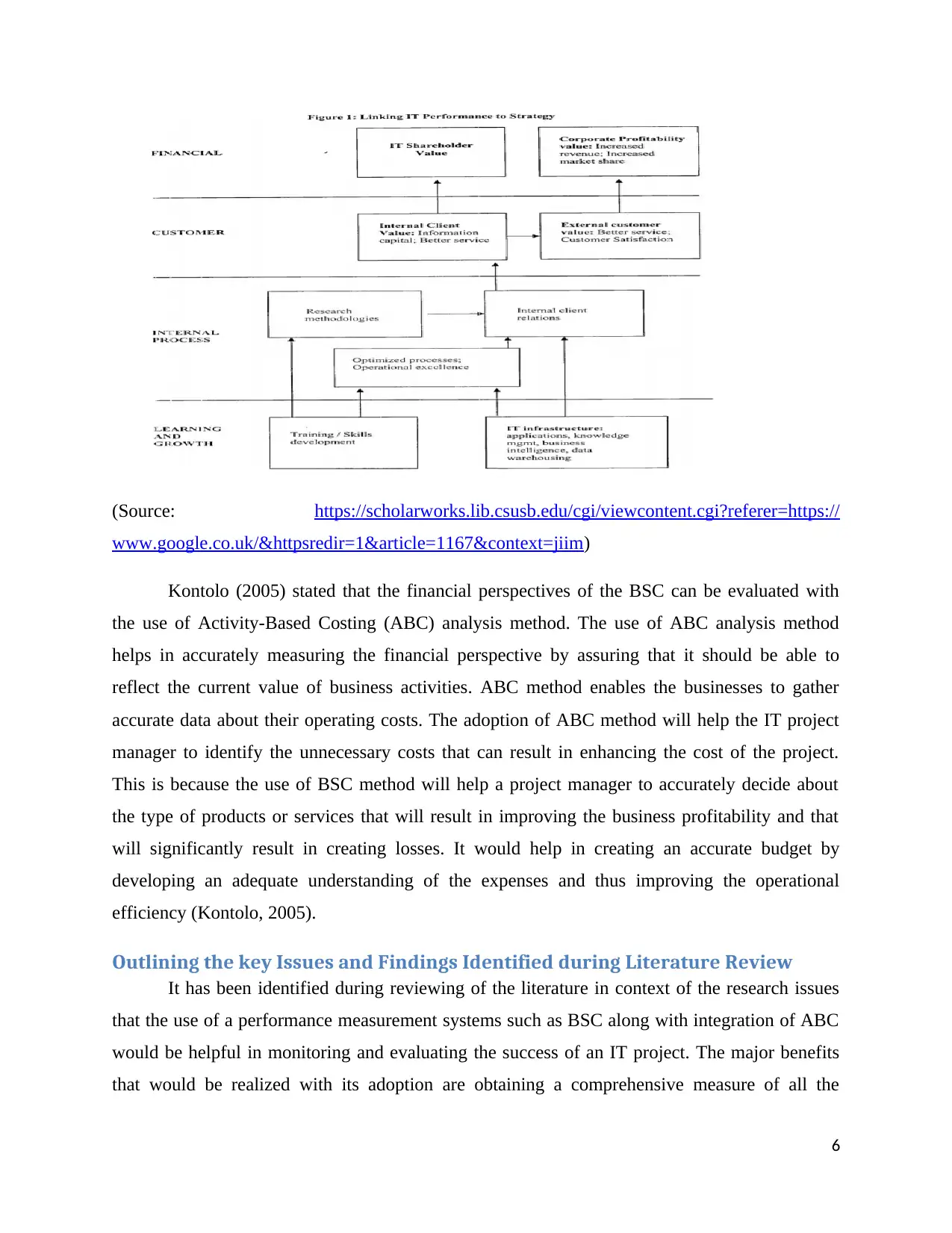
(Source: https://scholarworks.lib.csusb.edu/cgi/viewcontent.cgi?referer=https://
www.google.co.uk/&httpsredir=1&article=1167&context=jiim)
Kontolo (2005) stated that the financial perspectives of the BSC can be evaluated with
the use of Activity-Based Costing (ABC) analysis method. The use of ABC analysis method
helps in accurately measuring the financial perspective by assuring that it should be able to
reflect the current value of business activities. ABC method enables the businesses to gather
accurate data about their operating costs. The adoption of ABC method will help the IT project
manager to identify the unnecessary costs that can result in enhancing the cost of the project.
This is because the use of BSC method will help a project manager to accurately decide about
the type of products or services that will result in improving the business profitability and that
will significantly result in creating losses. It would help in creating an accurate budget by
developing an adequate understanding of the expenses and thus improving the operational
efficiency (Kontolo, 2005).
Outlining the key Issues and Findings Identified during Literature Review
It has been identified during reviewing of the literature in context of the research issues
that the use of a performance measurement systems such as BSC along with integration of ABC
would be helpful in monitoring and evaluating the success of an IT project. The major benefits
that would be realized with its adoption are obtaining a comprehensive measure of all the
6
www.google.co.uk/&httpsredir=1&article=1167&context=jiim)
Kontolo (2005) stated that the financial perspectives of the BSC can be evaluated with
the use of Activity-Based Costing (ABC) analysis method. The use of ABC analysis method
helps in accurately measuring the financial perspective by assuring that it should be able to
reflect the current value of business activities. ABC method enables the businesses to gather
accurate data about their operating costs. The adoption of ABC method will help the IT project
manager to identify the unnecessary costs that can result in enhancing the cost of the project.
This is because the use of BSC method will help a project manager to accurately decide about
the type of products or services that will result in improving the business profitability and that
will significantly result in creating losses. It would help in creating an accurate budget by
developing an adequate understanding of the expenses and thus improving the operational
efficiency (Kontolo, 2005).
Outlining the key Issues and Findings Identified during Literature Review
It has been identified during reviewing of the literature in context of the research issues
that the use of a performance measurement systems such as BSC along with integration of ABC
would be helpful in monitoring and evaluating the success of an IT project. The major benefits
that would be realized with its adoption are obtaining a comprehensive measure of all the
6
⊘ This is a preview!⊘
Do you want full access?
Subscribe today to unlock all pages.

Trusted by 1+ million students worldwide
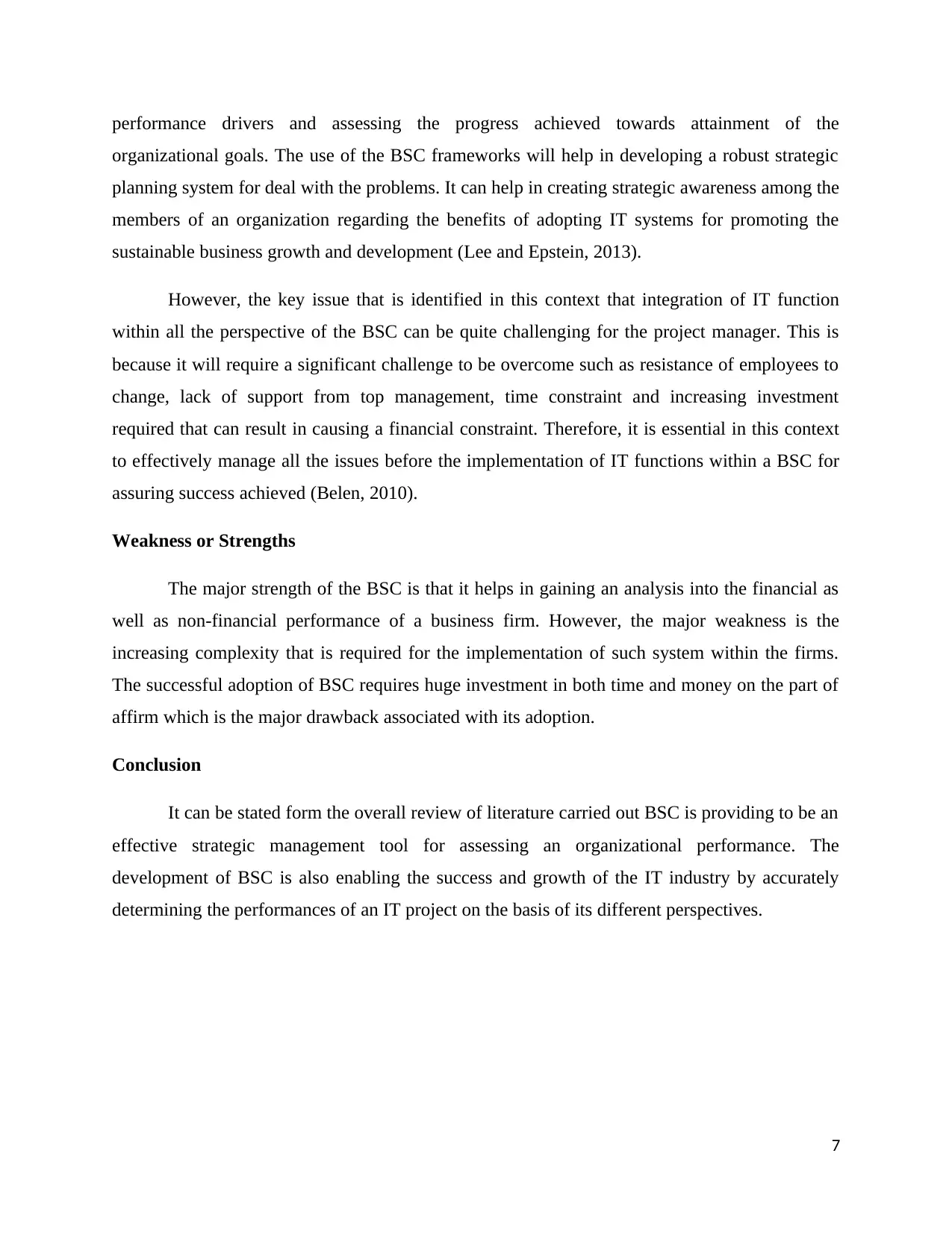
performance drivers and assessing the progress achieved towards attainment of the
organizational goals. The use of the BSC frameworks will help in developing a robust strategic
planning system for deal with the problems. It can help in creating strategic awareness among the
members of an organization regarding the benefits of adopting IT systems for promoting the
sustainable business growth and development (Lee and Epstein, 2013).
However, the key issue that is identified in this context that integration of IT function
within all the perspective of the BSC can be quite challenging for the project manager. This is
because it will require a significant challenge to be overcome such as resistance of employees to
change, lack of support from top management, time constraint and increasing investment
required that can result in causing a financial constraint. Therefore, it is essential in this context
to effectively manage all the issues before the implementation of IT functions within a BSC for
assuring success achieved (Belen, 2010).
Weakness or Strengths
The major strength of the BSC is that it helps in gaining an analysis into the financial as
well as non-financial performance of a business firm. However, the major weakness is the
increasing complexity that is required for the implementation of such system within the firms.
The successful adoption of BSC requires huge investment in both time and money on the part of
affirm which is the major drawback associated with its adoption.
Conclusion
It can be stated form the overall review of literature carried out BSC is providing to be an
effective strategic management tool for assessing an organizational performance. The
development of BSC is also enabling the success and growth of the IT industry by accurately
determining the performances of an IT project on the basis of its different perspectives.
7
organizational goals. The use of the BSC frameworks will help in developing a robust strategic
planning system for deal with the problems. It can help in creating strategic awareness among the
members of an organization regarding the benefits of adopting IT systems for promoting the
sustainable business growth and development (Lee and Epstein, 2013).
However, the key issue that is identified in this context that integration of IT function
within all the perspective of the BSC can be quite challenging for the project manager. This is
because it will require a significant challenge to be overcome such as resistance of employees to
change, lack of support from top management, time constraint and increasing investment
required that can result in causing a financial constraint. Therefore, it is essential in this context
to effectively manage all the issues before the implementation of IT functions within a BSC for
assuring success achieved (Belen, 2010).
Weakness or Strengths
The major strength of the BSC is that it helps in gaining an analysis into the financial as
well as non-financial performance of a business firm. However, the major weakness is the
increasing complexity that is required for the implementation of such system within the firms.
The successful adoption of BSC requires huge investment in both time and money on the part of
affirm which is the major drawback associated with its adoption.
Conclusion
It can be stated form the overall review of literature carried out BSC is providing to be an
effective strategic management tool for assessing an organizational performance. The
development of BSC is also enabling the success and growth of the IT industry by accurately
determining the performances of an IT project on the basis of its different perspectives.
7
Paraphrase This Document
Need a fresh take? Get an instant paraphrase of this document with our AI Paraphraser
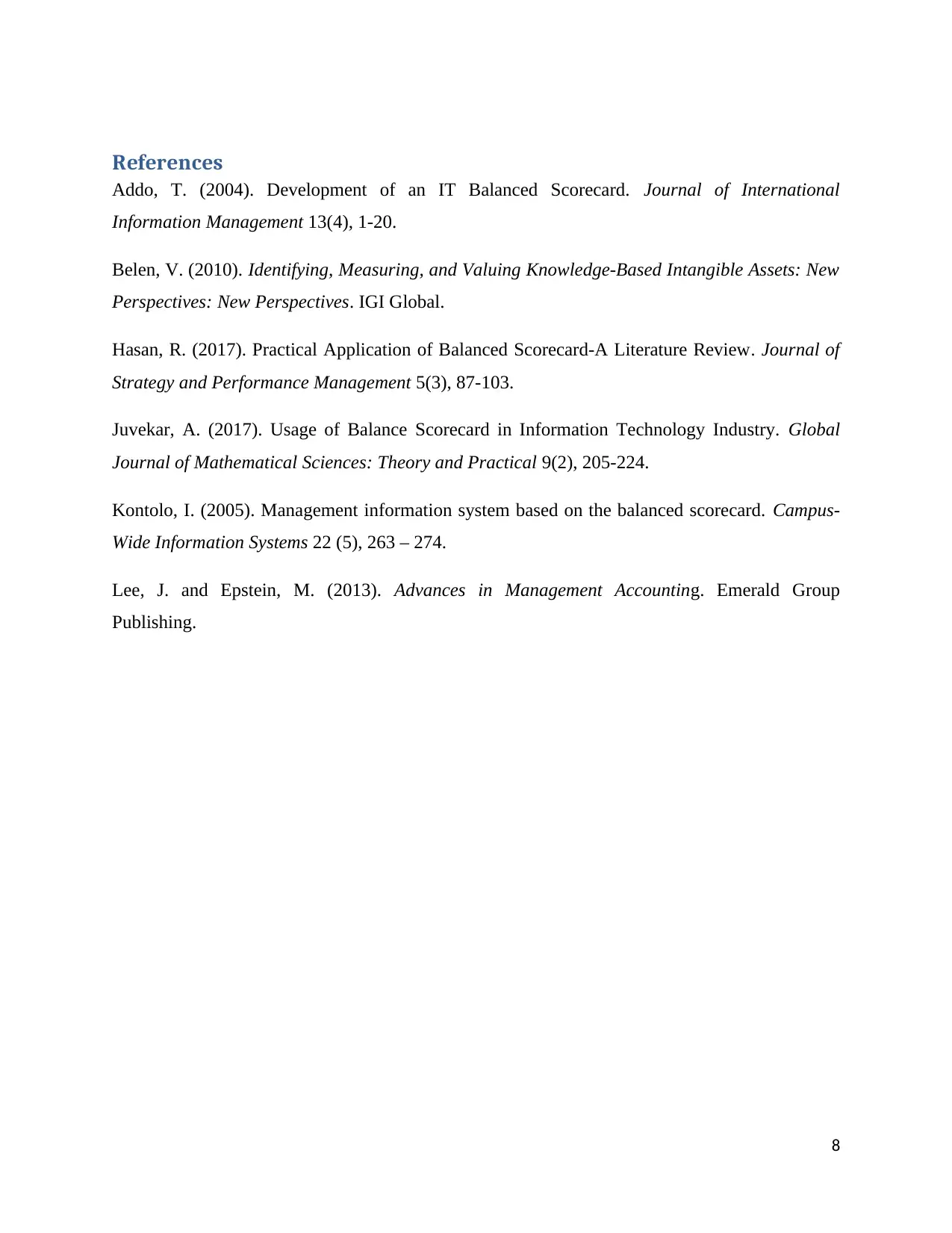
References
Addo, T. (2004). Development of an IT Balanced Scorecard. Journal of International
Information Management 13(4), 1-20.
Belen, V. (2010). Identifying, Measuring, and Valuing Knowledge-Based Intangible Assets: New
Perspectives: New Perspectives. IGI Global.
Hasan, R. (2017). Practical Application of Balanced Scorecard-A Literature Review. Journal of
Strategy and Performance Management 5(3), 87-103.
Juvekar, A. (2017). Usage of Balance Scorecard in Information Technology Industry. Global
Journal of Mathematical Sciences: Theory and Practical 9(2), 205-224.
Kontolo, I. (2005). Management information system based on the balanced scorecard. Campus-
Wide Information Systems 22 (5), 263 – 274.
Lee, J. and Epstein, M. (2013). Advances in Management Accounting. Emerald Group
Publishing.
8
Addo, T. (2004). Development of an IT Balanced Scorecard. Journal of International
Information Management 13(4), 1-20.
Belen, V. (2010). Identifying, Measuring, and Valuing Knowledge-Based Intangible Assets: New
Perspectives: New Perspectives. IGI Global.
Hasan, R. (2017). Practical Application of Balanced Scorecard-A Literature Review. Journal of
Strategy and Performance Management 5(3), 87-103.
Juvekar, A. (2017). Usage of Balance Scorecard in Information Technology Industry. Global
Journal of Mathematical Sciences: Theory and Practical 9(2), 205-224.
Kontolo, I. (2005). Management information system based on the balanced scorecard. Campus-
Wide Information Systems 22 (5), 263 – 274.
Lee, J. and Epstein, M. (2013). Advances in Management Accounting. Emerald Group
Publishing.
8
1 out of 8
Related Documents
Your All-in-One AI-Powered Toolkit for Academic Success.
+13062052269
info@desklib.com
Available 24*7 on WhatsApp / Email
![[object Object]](/_next/static/media/star-bottom.7253800d.svg)
Unlock your academic potential
Copyright © 2020–2025 A2Z Services. All Rights Reserved. Developed and managed by ZUCOL.




